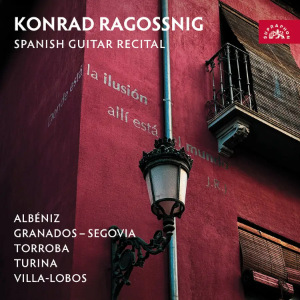
Spanish Guitar Recital
Heitor Villa-Lobos (1887-1959)
Five Preludes
Isaac Albeniz (1860-1909)
Asturias
Federico Moreno Torroba (1891-1982)
Arada
Madroñas
Joaquín Turina (1882-1949)
Fandanguillo Op. 36
Enrique Granados (1867-1916)
Andaluza No 5 Op.37
Konrad Ragossnig (guitar)
rec. 1969, Domoniva Studio, Prague
Supraphon SU4358-2 [41]
The following extract is from a review of May 1963, published in a local Melbourne, Australia newspaper: “His playing is relaxed, graceful and acutely sensitive to subtleties of dynamics and tonal colours. Except for Segovia, it was easily the most beautiful playing I have heard”. José Luis González was 31 years of age, and in his prime as a concert guitarist. Segovia had given his Australian inaugural concert a couple of years earlier. However, independent of unique excellence, the long shadow of Segovia was cast over those few superior guitarists who were concertizing at that time. On Oct. 22, 1960 the magnificent guitarist Alirio Diaz played the Chaconne from Bach’s BWV 1004.at the Wigmore Hall in London. A review from The Times of the rendition concluded that, in comparison to Segovia, it was merely small and glib. Three centuries earlier the excellent Baroque composer Johann Fasch suffered a similar fate: the shadow of J.S.Bach was long and enveloping.
Another outstanding guitarist who was also caught up in that long shadow was Konrad Ragossnig, an exact contemporary of José Luis González. In 1961 Segovia had declared that the most outstanding guitarists of the younger generation were José Tomás, José Luis González, Alirio Díaz and John Williams; he did not include Julian Bream or Konrad Ragossnig.
Ragossnig was born in Klagenfurt in 1932. In 1948 he began studying at the conservatorium of his birth city; but his instrument was the cello. He commenced teaching himself the guitar at the age of nine. His love of the guitar won, and in 1954 he enrolled at Vienna’s Academy of Music and Performing Arts to study the guitar under Karl Scheit. By 1956 he was already teaching guitar at the Klagenfurt conservatorium and a year later he became head of the chamber music department at the Austrian Broadcasting studio for Carinthia. In 1960 he studied in Spain with Andrés Segovia. The following year Ragossnig won the most prestigious guitar competition of the day, held in Paris by France’s radio and TV broadcasting corporation. In 1983 he was appointed Professor of Guitar at the Vienna Academy of Music and Performing Arts, where he taught until 2000.
Ragossnig was a renowned concert artist, making appearances as a soloist and with symphony and chamber orchestras in Europe, the USA and the Far East. It should also be remembered that Ragossnig was also an excellent lutenist who, like Julian Bream, ignored tradition, and played with finger nails. A prolific recording artist, he appears in more than seventy albums of solo, chamber, and orchestral compositions. Included among those is his splendid duo album with guitarist Oscar Caceres.
The review programme is being released for the first time in CD format. Originally recorded in 1969, it was reissued several times between 1971 and 1980. The eleven programme items are all from the pens of Spanish and South American composers. Well known, they form a staple part of the instrument’s repertory. Nine are original compositions for the guitar, the remainder transcriptions of piano music.
The playing on this CD presents the guitar in its very best light. Technically and musically it is superior, and compares favourably with discs currently being made of similar repertory. Stylistically it is a child of the era, but few would view that as a shortcoming. Fashion may come and go, but style endures.
The sonic quality of the recording is excellent, and via this virtue we come to a fuller appreciation of how clear and sonorous was the tone with which Ragossnig played.
The programme is rather short at 41 minutes but reminds one of a comment by Benjamin Britten to Julian Bream about de Falla’s Homenaje: ‘That piece of music is only seven minutes long (actually three) but there is twenty minutes of music in it’.
Zane Turner
Buying this recording via a link below generates revenue for MWI, which helps the site remain free




















